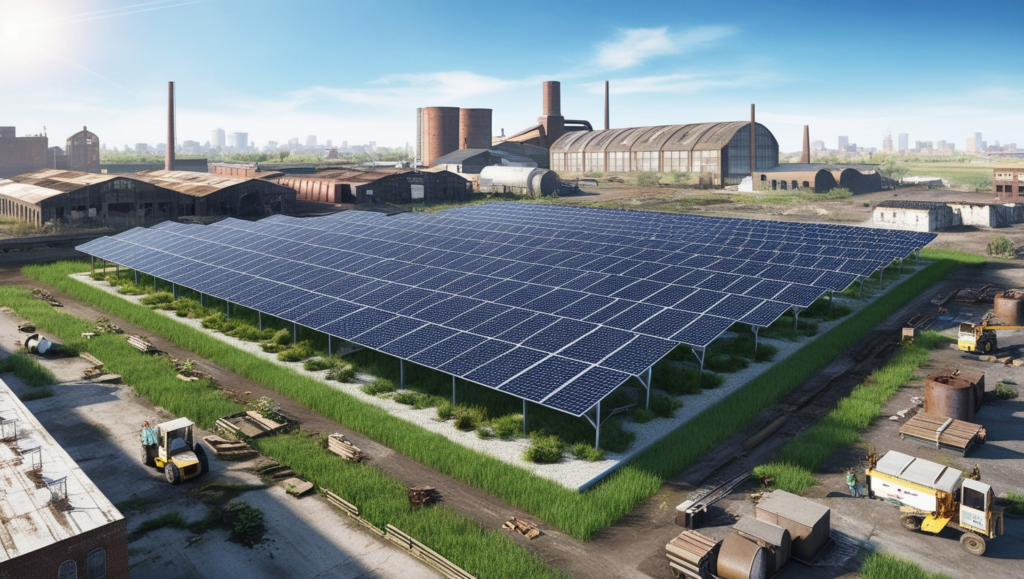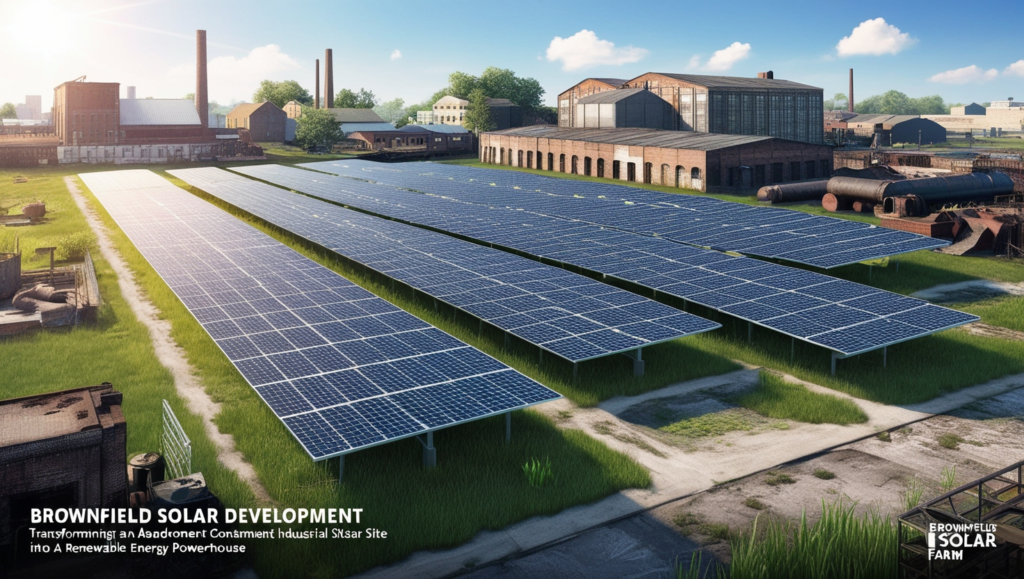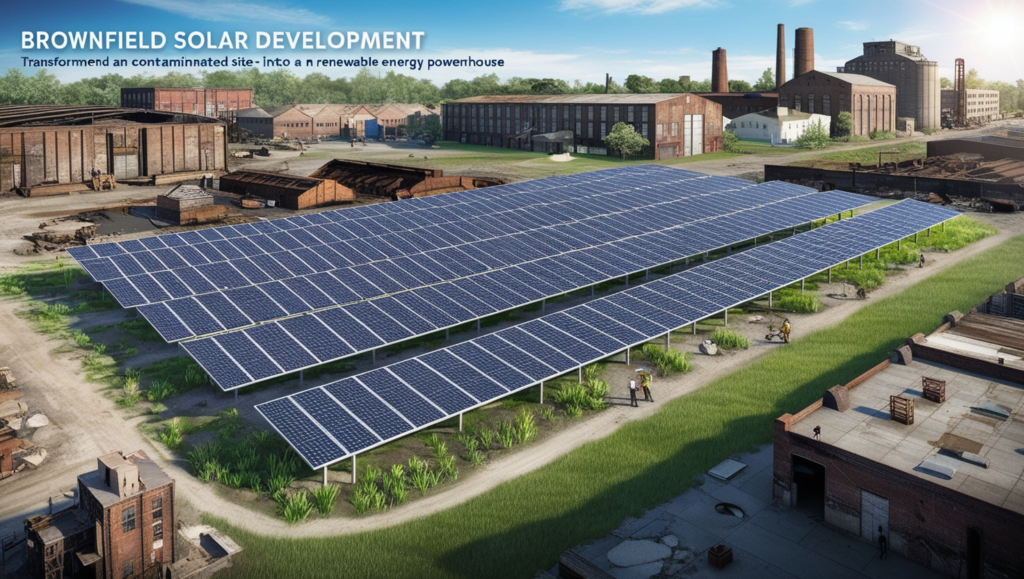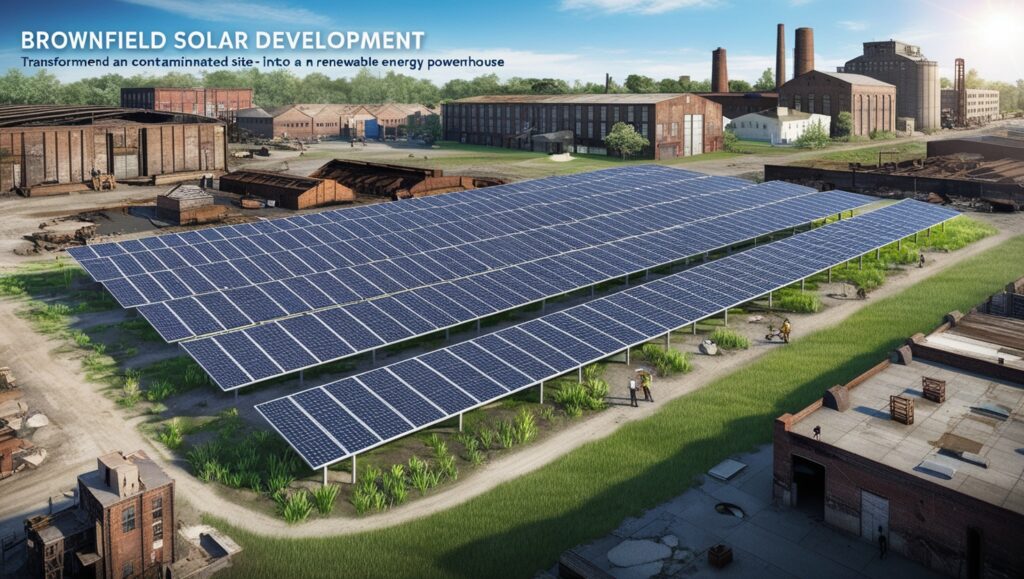Solar energy has become a cornerstone of the global shift toward renewable power, offering a path to a cleaner and more sustainable future. Yet, as demand for large-scale solar installations grows, so does the debate surrounding land use. Traditional solar farms often require vast expanses of open land, which can sometimes lead to conflicts over agricultural preservation, ecological balance, or urban development priorities.
But what if we could bypass these challenges by reimagining the potential of neglected spaces? Brownfield solar development offers an innovative solution by transforming contaminated, abandoned, or underutilized sites into productive energy hubs. These projects not only minimize competition for valuable land but also revitalize areas that might otherwise remain dormant, turning environmental liabilities into assets that drive progress. With brownfield solar development, we’re not just generating clean energy—we’re rethinking land use and creating opportunities for sustainable growth.
What Are Brownfields?
Brownfields are parcels of land that once served industrial or commercial purposes but now lie dormant due to contamination or other environmental concerns. These sites often come with a legacy of pollution, making them unsuitable for traditional development such as housing or farming. Examples of brownfields include:
- Abandoned factories and warehouses: Former industrial hubs now sitting idle with potential chemical or structural hazards.
- Former landfills or mining sites: Areas left barren from waste disposal or resource extraction activities.
- Vacant lots with environmental hazards: Spaces burdened with soil, water, or air contamination from previous uses.
While these properties may pose challenges for conventional reuse, they offer a unique opportunity for solar energy development. By leveraging innovative technologies and strategic planning, brownfields can be transformed into productive solar farms. This approach not only mitigates the environmental impact of these sites but also turns them into renewable energy assets, creating a win-win for sustainability and land revitalization.

Advantages of Brownfield Solar Development
Brownfield solar development offers a range of compelling advantages, both environmentally and economically, while benefiting from supportive policies that encourage renewable energy innovation.
Environmental Benefits
- Land Reclamation
Brownfield projects breathe new life into degraded and underutilized lands, converting them into productive energy hubs. This approach reduces the pressure to convert pristine ecosystems, such as farmlands or forests, into solar farms, preserving biodiversity and natural landscapes. - Pollution Mitigation
Solar installations can serve as a protective cap over contaminated soil, preventing the spread of pollutants. This dual-purpose approach not only generates clean energy but also helps contain environmental hazards, reducing the long-term ecological footprint of these sites.
Economic Benefits
- Cost-Effective Land Use
Brownfields are often available at a lower cost compared to undeveloped or high-demand real estate. This affordability makes them an attractive option for solar developers, enabling financially sustainable projects that maximize returns. - Job Creation
The redevelopment of brownfields stimulates local economies by generating jobs, both during construction and for ongoing operations and maintenance. These projects offer employment opportunities in engineering, labor, and renewable energy management, providing economic uplift to surrounding communities.
Policy and Incentives
Governments and regulatory bodies actively promote renewable energy development on brownfields through:
- Tax Credits: Financial incentives that reduce the cost burden for developers investing in these projects.
- Grants: Funding opportunities aimed at offsetting initial setup costs for brownfield solar installations.
- Expedited Permitting: Streamlined approval processes make it easier to initiate and complete projects efficiently.
By leveraging these incentives, developers can make brownfield solar projects more economically feasible, accelerating the adoption of renewable energy while addressing legacy land use challenges.
The combination of environmental restoration, economic development, and policy support makes brownfield solar development a transformative solution for a cleaner, more sustainable future.

Challenges in Brownfield Solar Development
While brownfield solar projects offer significant benefits, they also come with unique challenges that developers must navigate to ensure success.
Site Contamination
- Complex Environmental Assessments
Brownfields are often contaminated with hazardous substances due to their past industrial or commercial uses. Before any solar installation can begin, developers must conduct thorough environmental assessments to evaluate the extent of contamination. - Costly Remediation Efforts
Addressing contamination issues can be expensive and time-intensive. Depending on the severity of the pollution, remediation efforts may involve soil treatment, groundwater management, or the installation of protective barriers, all of which can increase project costs.
Regulatory Hurdles
- Layered Regulations
Brownfields are subject to federal, state, and local regulations, which can vary significantly based on location and site history. Navigating these regulatory frameworks requires expertise and careful planning. - Time-Consuming Approval Processes
Securing necessary permits and approvals for brownfield solar development can be a lengthy process. However, building collaborative relationships with regulatory agencies can help expedite reviews and approvals.
Infrastructure and Access
- Limited Grid Connectivity
Many brownfields are situated in areas with inadequate infrastructure, particularly when it comes to connections to the electrical grid. Developing the necessary grid infrastructure can add to the overall cost and complexity of the project. - Transportation Challenges
Some brownfields are located in remote or urban areas with limited transportation access, making it more difficult to deliver materials and equipment to the site. Developers may need to invest in upgrading roads or other transportation networks to ensure smooth project execution.
While these challenges may seem daunting, innovative solutions and strategic partnerships can help developers overcome these obstacles. By addressing site-specific issues, brownfield solar projects can unlock their full potential, transforming previously unusable land into valuable clean energy assets.
Successful Examples of Brownfield Solar Projects
Brownfield solar projects are more than just theoretical possibilities—they’ve already been implemented successfully in various locations worldwide. These projects showcase how innovative thinking can repurpose neglected land for clean energy generation, benefiting both the environment and local communities.
The Steel Sun Project (Baltimore, Maryland)
- Overview: Located on the site of a former steel mill, this solar farm has transformed a contaminated industrial area into a hub for renewable energy.
- Impact: The project generates 13 MW of electricity, enough to power thousands of homes in the region.
- Significance: By revitalizing an abandoned site, the Steel Sun Project demonstrates the potential for industrial reclamation to advance renewable energy and support local sustainability goals.
Renewable Energy Park (Brighton, UK)
- Overview: A former landfill in Brighton has been converted into a renewable energy park featuring both solar and wind energy installations.
- Impact: This innovative project generates substantial renewable energy while eliminating the environmental risks associated with an unmanaged landfill.
- Significance: By turning a liability into a community asset, the Renewable Energy Park exemplifies how diverse renewable technologies can coexist to maximize land utility.
Reclaiming Mines in Pennsylvania
- Overview: Abandoned coal mines in Pennsylvania have been repurposed for solar energy production as part of a broader effort to transition from fossil fuels to clean energy.
- Impact: These solar farms provide renewable energy while addressing the environmental degradation caused by mining activities.
- Significance: This initiative highlights how areas once dominated by fossil fuel industries can lead the way in renewable energy adoption, showcasing the economic and environmental benefits of this transition.

Why Brownfield Solar Development Matters
Brownfield solar development is not just a solution for utilizing land that is otherwise considered unusable—it’s a key strategy in addressing several broader global challenges. By transforming neglected, contaminated, or abandoned sites into clean energy powerhouses, brownfield solar projects contribute to sustainability, resource efficiency, and energy equity. These initiatives address multiple environmental and societal issues, making them an essential part of the renewable energy transition. Here’s how:
1. Climate Change Mitigation
At the heart of the global movement toward renewable energy is the urgent need to mitigate climate change. Brownfield solar development plays a crucial role in this effort. Solar energy systems, powered by the sun’s abundant and renewable energy, help reduce our reliance on fossil fuels—one of the primary contributors to greenhouse gas emissions.
By repurposing brownfield sites for solar energy production, we can generate clean, renewable power without further taxing the environment. These projects directly contribute to reducing carbon footprints, helping to slow the effects of global warming. In addition, large-scale solar power generation can support the transition away from coal, natural gas, and oil-based energy, further accelerating efforts to combat climate change.
2. Land Preservation
One of the most compelling reasons for brownfield solar development is its ability to conserve agricultural and natural land. As the demand for renewable energy grows, finding suitable land for solar farms becomes increasingly important. Without brownfield solar projects, the push for large-scale solar development could result in the loss of valuable farmland, forests, and natural habitats.
By choosing brownfields—often located in urban or industrial areas—developers can avoid disturbing ecosystems or agricultural land that is essential for food production. This is particularly significant given the global pressure to protect biodiversity and ensure that our agricultural resources remain intact for future generations.
Brownfield solar development allows for productive land use without compromising the environment, demonstrating that energy generation and land preservation can coexist. It also alleviates the need to encroach on untouched landscapes, balancing the demand for clean energy with the need to protect vital ecosystems.
3. Community Revitalization
Beyond environmental benefits, brownfield solar projects can play a transformative role in revitalizing communities. Many brownfield sites are located in economically distressed areas, where industrial decline has left behind vacant, polluted land. By investing in solar energy projects on these sites, developers not only clean up environmental hazards but also breathe new life into communities.
The process of revitalization begins with the economic benefits these projects bring. Solar farms create jobs in construction, site preparation, and ongoing operation and maintenance. These new employment opportunities can help boost the local economy, providing stable, long-term positions in areas that may have limited job prospects.
Moreover, brownfield solar development can improve the overall quality of life for local residents. As these sites are transformed from eyesores to productive energy assets, communities experience enhanced property values and a renewed sense of pride. Additionally, Powerhouse projects can provide local municipalities with new revenue streams, supporting public services and infrastructure.
In cases where the solar farm includes community solar programs, local residents may also benefit from affordable, clean energy, making energy access more equitable. This can be particularly impactful in marginalized communities where traditional energy infrastructure may have been inadequate or expensive.
How You Can Advocate for Brownfield Solar
Advocating for brownfield solar development is crucial to accelerating the widespread adoption of this innovative solution. As an individual, community member, or professional in the renewable energy sector, there are several ways you can actively contribute to promoting these projects. By supporting policies, encouraging partnerships, and raising awareness, you can help drive the change needed to turn abandoned sites into valuable energy assets for future generations.
1. Support Policies
Advocating for policies that prioritize the redevelopment of brownfields for renewable energy projects is one of the most impactful ways to foster the growth of brownfield solar. Governments play a key role in shaping the regulatory landscape for these initiatives, and their support can significantly reduce barriers to entry for developers.
You can support policies by:
- Engaging with Policymakers: Reach out to local, state, or national policymakers to express support for legislation that incentivizes brownfield solar development. Highlight how these projects contribute to environmental sustainability, job creation, and land preservation.
- Advocating for Tax Incentives and Grants: Advocate for financial incentives such as tax credits, grants, and subsidies that make brownfield solar projects more financially viable. These incentives can help offset the costs associated with site remediation and other hurdles in the development process.
- Promoting Zoning and Land Use Reform: Encourage local governments to adopt zoning laws and land use policies that prioritize renewable energy development on brownfields. By making these sites more accessible for solar projects, cities and municipalities can revitalize blighted areas and meet renewable energy goals.
2. Encourage Partnerships
Brownfield solar projects thrive when there is collaboration between various stakeholders. Governments, private developers, and local communities all have a role to play in ensuring these projects succeed. By fostering partnerships, you can help streamline the development process and ensure that brownfield solar initiatives are both sustainable and beneficial to all involved.
You can encourage partnerships by:
- Facilitating Collaboration Between Sectors: Work to bring together the public and private sectors, environmental organizations, and community groups to create a unified approach to brownfield solar development. By aligning the interests of different stakeholders, you can create a more efficient and impactful process.
- Supporting Community Engagement: Engage local communities in the planning and decision-making process. It’s important for residents to understand the benefits of brownfield solar development and have a voice in the projects that affect their neighborhoods. This can help address concerns and build local support.
- Building Relationships with Developers: Encourage conversations between local governments and developers to discuss the potential of brownfield sites for solar energy projects. Developers can bring technical expertise, while local governments can provide the necessary regulatory framework and incentives.
3. Educate Others
Raising awareness about the benefits of brownfield solar projects is essential to driving public and private sector interest in these initiatives. Many people are unaware of the potential that brownfield sites offer for renewable energy development. By educating others, you can help build momentum for brownfield solar projects and highlight their importance in addressing climate change, economic challenges, and land-use issues.
You can educate others by:
- Organizing Information Sessions or Workshops: Host events to share information about brownfield solar development with local communities, businesses, and policymakers. These sessions can help demystify the process and show how brownfields can be transformed into productive energy assets.
- Using Social Media and Online Platforms: Leverage social media platforms to share success stories, case studies, and news about brownfield solar projects. By creating informative content, you can reach a larger audience and generate interest in the potential of these projects.
- Creating Partnerships with Educational Institutions: Collaborate with universities, research institutes, and environmental organizations to produce educational materials or host public forums on the topic of brownfield solar development. Raising awareness among students, educators, and thought leaders can help inspire the next generation of energy innovators.
- Advocating for Media Coverage: Work with journalists and media outlets to feature stories on the benefits of brownfield solar projects. The media plays a crucial role in shaping public opinion, and coverage of successful projects can inspire others to support similar initiatives.

Conclusion
Brownfield solar development represents a powerful and transformative solution to some of the most pressing environmental and societal challenges of our time. These projects have the unique ability to turn abandoned, contaminated, and neglected lands into sources of clean, renewable energy, offering a win-win scenario for both the environment and local communities. By reclaiming these wastelands and transforming them into sustainable energy hubs, we can make significant strides toward a cleaner, greener future while addressing critical land-use concerns.
As the world faces the urgent need to combat climate change, brownfield solar development offers an innovative pathway to reduce greenhouse gas emissions and expand renewable energy sources. Solar energy—clean, abundant, and increasingly affordable—can be harnessed on sites that would otherwise remain unusable. Rather than encroaching on valuable agricultural or natural lands, we are able to make productive use of spaces that have already been degraded or abandoned. This not only alleviates the pressure on farmlands and ecosystems but also helps preserve the natural environment for future generations.
But the impact of brownfield solar development extends beyond environmental benefits. These projects have the power to revitalize communities, particularly those that have been economically impacted by industrial decline. By transforming brownfields into solar energy hubs, we can breathe new life into local economies, create jobs, and provide affordable, clean energy to surrounding areas. The revival of these sites can also improve property values and the overall quality of life for residents, turning eyesores into assets that benefit everyone.
The potential of brownfield solar development is vast, and the time to embrace this transformative approach is now. As technology advances and policy support increases, the untapped potential of these forgotten lands can be realized, contributing to the broader goals of sustainability, energy equity, and climate change mitigation.
Together, we have the opportunity to turn environmental challenges into opportunities—creating a sustainable energy future while revitalizing communities and restoring ecosystems. By championing brownfield solar development, we are taking an important step toward a more sustainable, resilient, and equitable world.









